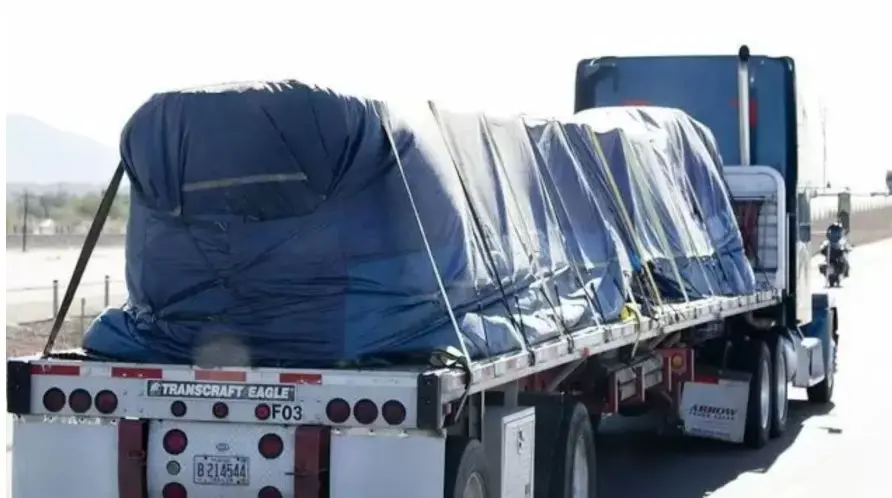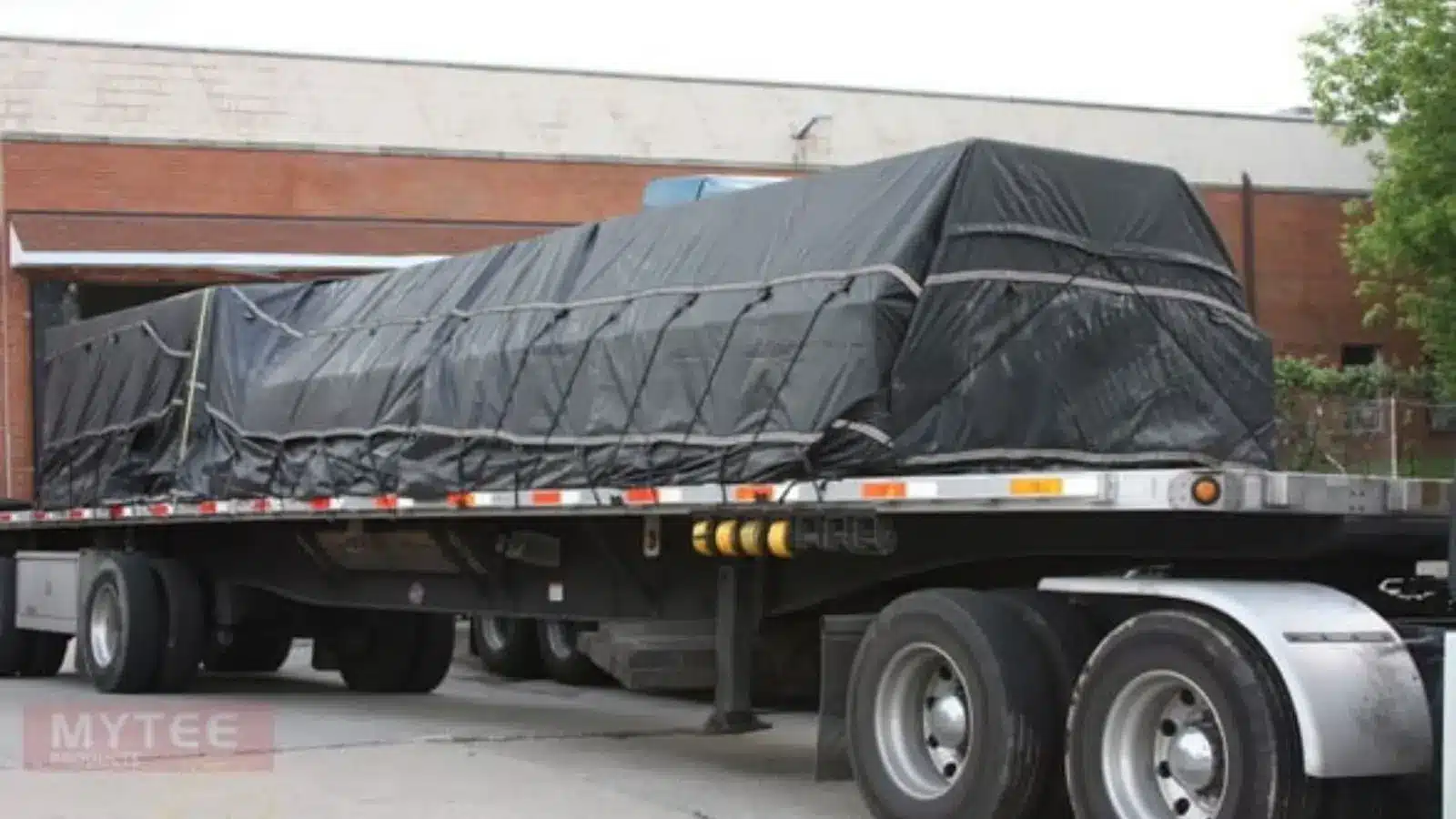Choosing the right flatbed truck tarps material and thickness is essential for keeping your cargo safe and secure during transport. Whether you’re hauling lumber, steel, or equipment, the right tarp protects your load from the elements, reducing damage and making your job easier.
Understanding the right material and thickness for your specific cargo can be confusing. This guide breaks it down simply, helping you select the best tarp based on your needs, whether it’s lightweight or heavy-duty cargo. Let’s dive in and make sure you get the best protection for your valuable load.
Introduction: Why the Right Tarp Matters for Cargo Protection
When it comes to transporting cargo, choosing the right flatbed truck tarp is crucial for protecting your goods. A high-quality tarp not only shields your cargo from weather elements like rain, wind, and sun but also ensures that everything stays secure during the journey. Without the proper tarp, you risk damage to your goods and, in some cases, legal trouble.
Protection from the Elements
The right tarp protects your cargo from rain, snow, and UV rays, which can all cause damage over time. For example, rain can ruin sensitive items like machinery or electronics, while prolonged exposure to the sun can cause fading or drying out of materials like wood or fabric. A good tarp prevents these issues, keeping your cargo in top condition.
Preventing Cargo Shifting
Another important reason to use the correct tarp is to prevent cargo from shifting. If your tarp isn’t strong enough or doesn’t fit well, items on the flatbed can move around, which could lead to accidents. A properly fitted, sturdy tarp ensures your cargo stays in place throughout the trip.
In short, choosing the right flatbed truck tarp is essential for keeping your cargo safe and secure. It helps protect against weather, reduces the risk of damage, and keeps everything in place. When you get it right, your load will arrive safely and in great condition.
Understanding Different Flatbed Tarp Materials
Choosing the right material for your flatbed truck tarp is just as important as selecting the right thickness. The material determines how well your tarp will protect your cargo from the elements, how durable it is, and how easy it is to handle. Let’s take a look at some of the most common flatbed tarp materials and what makes them unique.
1. Polyethylene (PE) Tarps
Polyethylene tarps are lightweight, water-resistant, and budget-friendly. They are ideal for short trips or loads that don’t require heavy-duty protection. While they may not offer the same level of durability as other materials, they work well for general cargo, such as boxes or bulk items, and can be a good option for light-duty uses.
2. Vinyl (PVC) Tarps
Vinyl tarps are thicker, more durable, and offer superior protection compared to polyethylene. These tarps are waterproof, UV-resistant, and can withstand harsher weather conditions. If you’re transporting heavy or sensitive cargo like machinery, steel, or lumber, vinyl tarps are the way to go. They provide excellent protection for long hauls and tough conditions.
3. Canvas Tarps
Canvas is a breathable, eco-friendly material that’s great for protecting cargo from moisture. Unlike vinyl, it allows air to circulate, making it ideal for loads that need ventilation, like plants or organic materials. However, canvas tarps aren’t waterproof, so they may not be the best choice for wet conditions.
4. Mesh Tarps
Mesh tarps are perfect for loads like gravel, debris, or any material that benefits from airflow. The open weave allows wind to pass through, reducing drag and keeping lighter items in place. These tarps are less protective from rain but are excellent for keeping materials covered while still letting air flow.
Choosing the Right Tarp Thickness Based on Cargo Weight and Environment

When selecting a flatbed truck tarp, thickness is just as important as material. The right thickness ensures that your tarp can handle the weight of your cargo and protect it from the environment. Let’s break down how to choose the perfect tarp thickness based on the type of load and the conditions you’ll be facing.
1. Light-Duty Loads (10-14 Mils)
If you’re hauling lightweight cargo, such as boxes, bags, or pallets, a lighter tarp is usually sufficient. A tarp thickness of 10-14 mils is a good choice for short trips or low-risk loads. These tarps are flexible and easy to handle, but they’re not built to withstand extreme weather or heavy impacts. They provide basic protection from rain, dust, and debris.
2. Medium-Duty Loads (16-18 Mils)
For most standard loads like building materials, furniture, or bulk items, a medium-duty tarp (16-18 mils thick) offers the right balance of protection and flexibility. These tarps are durable enough to withstand moderate weather conditions like heavy rain or wind, and they can handle a bit of weight without tearing or sagging. They are ideal for typical flatbed trucking needs and can be used for medium-to-long-distance travel.
3. Heavy-Duty Loads (20+ Mils)
If you’re hauling heavy cargo, such as machinery, steel, or large equipment, you’ll need a thicker tarp; usually 20 mils or more. Heavy-duty tarps are designed to resist tearing, punctures, and abrasions. They also provide superior protection from extreme weather, such as heavy rain, snow, or high winds. A thick tarp ensures that your cargo stays secure and undamaged during long hauls, even in tough conditions.
4. Environmental Factors
The environment you’ll be traveling through is another key factor in choosing tarp thickness. If you’re dealing with extreme heat, UV exposure, or heavy rainfall, a thicker, more durable tarp is necessary to withstand those conditions. On the other hand, if you’re transporting in more temperate or controlled environments, a lighter tarp might be enough.
Matching Cargo Type with Tarp Material and Thickness
Choosing the right tarp material and thickness depends on the type of cargo you’re hauling. Different materials and thicknesses provide different levels of protection, and matching them correctly ensures your cargo stays secure and undamaged. Let’s explore which tarp works best for various cargo types.
1. Lumber and Building Materials
Lumber and other construction materials require strong, durable protection. Vinyl tarps (16-22 oz) are perfect for these loads because they are heavy-duty, tear-resistant, and waterproof. This thickness ensures the tarp can handle the weight of the wood, prevent it from shifting, and protect it from rain, wind, or UV damage during transportation.
2. Steel Coils and Heavy Machinery
For steel coils, heavy machinery, or other large, sharp-edged items, you need a thick, heavy-duty vinyl tarp; typically around 20 mils or more. These items can easily tear through lighter materials, so a strong tarp ensures that your cargo stays protected. Look for tarps with reinforced edges and grommets to ensure a secure fit and added durability.
3. Agricultural Products
When hauling agricultural goods like hay, plants, or grains, canvas tarps are a great choice. These tarps are breathable, allowing moisture to escape while still offering protection from rain and sun. For lighter agricultural loads, you can go with light to medium-duty tarps (around 12-16 mils), but for heavier items, opt for thicker tarps for better durability.
4. Debris and Loose Materials
For hauling gravel, sand, or other loose materials, mesh tarps are the best option. These allow for airflow and prevent the material from blowing off the flatbed while still keeping the load contained. A light to medium-duty mesh tarp will work well here, as it’s easier to handle, and the open weave reduces drag on the road.
5. Palletized Goods and Boxes
For boxed goods or palletized loads, a medium-duty tarp (16-18 mils) made from either polyethylene or vinyl works well. These tarps will protect your goods from rain, dirt, and dust while providing enough strength to secure the load. They’re versatile and suitable for a wide range of general cargo.
Conclusion
In the end, selecting the perfect flatbed truck tarp material and thickness ensures your cargo stays safe and secure. Take the time to consider your cargo type, travel conditions, and environment, and you’ll make an informed choice that keeps your transport hassle-free.
Also Read-Selecting the Right Tech Stack for Mobile App Success










